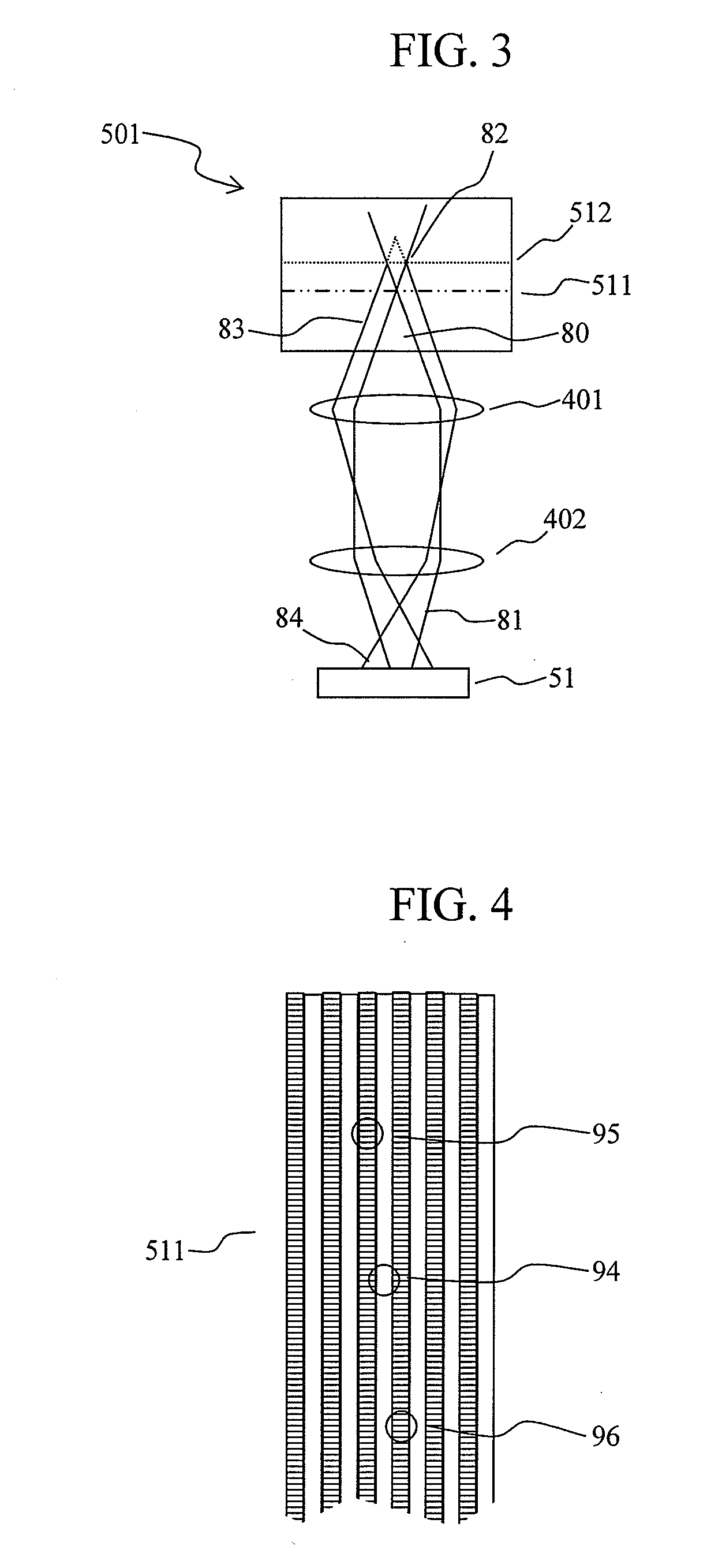Optical Pickup Apparatus and Optical Disk Drive
a pickup apparatus and optical disc technology, applied in the direction of optical recording heads, instruments, data recording, etc., can solve the problems of imbalance in the tracking error signal and the interference effect, so as to reduce the fluctuation of the tracking error signal, reduce the fluctuation of the spp signal, and reduce the error in reading data
- Summary
- Abstract
- Description
- Claims
- Application Information
AI Technical Summary
Benefits of technology
Problems solved by technology
Method used
Image
Examples
embodiment 1
[0048]FIG. 1 shows an optical pickup apparatus for an optical disc drive. A semiconductor laser 101 emits laser light that is converted by a collimator lens 403 and a triangular prism 102 into a collimated, circular light beam. The collimated beam is divided into three beams by a diffraction grating 103; namely, one main beam and two sub-beams. While the direction of travel of the main beam is the same as the incident beam, the two sub-beams form emerging light having an inclination in symmetric directions with respect to the optical axis. Normally, the difference in the amount of light of the main beam and the sub-beams is set to be 10 times or greater. The three beams pass through a polarization beam splitter 104, converted by a quarter wavelength plate 105 into circularly polarized light, and then narrowed by an objective lens 404 onto a dual-layer optical disc 501 rotated by a rotation mechanism. In FIG. 1, the reading target layer (relevant layer) is 511, on which the minimum s...
embodiment 2
[0051]In Embodiment 2 shown in FIG. 2, the diffraction grating 103 and the polarization beam splitter 104 are disposed nearer the semiconductor laser 101 than a collimator lens 407. Thus, the laser light emitted by the semiconductor laser 101 passes through the polarization beam splitter 104 in the form of diverging light. The laser light is then converted into light beam collimated by the collimator lens 407, and then becomes incident on the quarter wavelength plate 105. The reflected light from the dual-layer optical disc 501 has its polarization direction changed by 90° and is then reflected by the polarization beam splitter 104. The reflected light passes through the split wavelength plate 20 and an astigmatism element 406, before being detected by the photodetector 52. The astigmatism element 406 may comprise a cylindrical lens. In the present embodiment, a number of components are disposed between the laser light source 101 and the collimator lens 407 with the polarization bea...
embodiment 3
[0052]In Embodiment 3, a split wavelength plate shown in FIG. 10 is used. The split wavelength plate 21 is inserted in the optical path in place of the split wavelength plate 20 of Embodiment 1. The region of influence of interference from the adjacent layer due to the sub-beams differs from that in the case of the split wavelength plate 20, as mentioned above. Assuming that four-quadrant photodetectors 541, 544, and 545 having the same configuration are used, the inputs from the four-quadrant detectors 544 and 545 into the electronic circuit 52 need to be changed.
[0053]FIG. 13 shows a signal processing circuit configured such that the push-pull signals for the sub-beams are formed by a diagonal combination of the four-quadrant detectors. When the relevant layer is changed, a push-pull signal from a diagonal combination having less influence from the adjacent layer is selected by a switch element 580, which is controlled by a layer selection control circuit 727. While the circuits o...
PUM
| Property | Measurement | Unit |
|---|---|---|
| wavelengths | aaaaa | aaaaa |
| angle | aaaaa | aaaaa |
| width | aaaaa | aaaaa |
Abstract
Description
Claims
Application Information
 Login to View More
Login to View More - R&D
- Intellectual Property
- Life Sciences
- Materials
- Tech Scout
- Unparalleled Data Quality
- Higher Quality Content
- 60% Fewer Hallucinations
Browse by: Latest US Patents, China's latest patents, Technical Efficacy Thesaurus, Application Domain, Technology Topic, Popular Technical Reports.
© 2025 PatSnap. All rights reserved.Legal|Privacy policy|Modern Slavery Act Transparency Statement|Sitemap|About US| Contact US: help@patsnap.com



